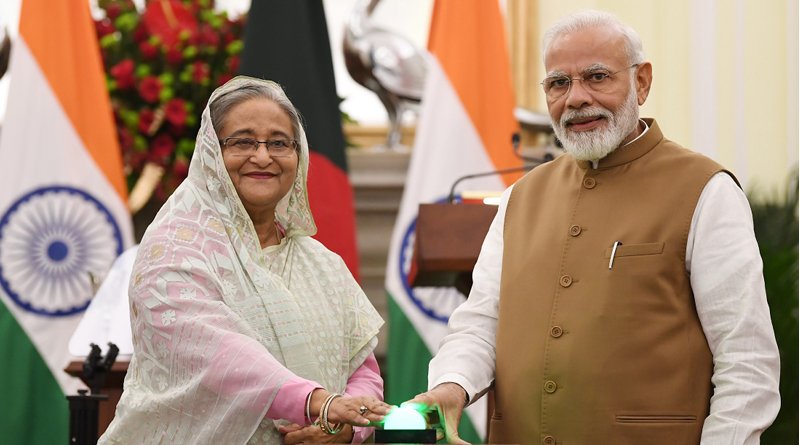It is no news that India’s valiant militaria efforts and aggressive political stance assisted in liberating Bangladesh from Pakistan in 1971. Numerous events in the recent past have testified to the strong ties both these nations share. For instance, during the 26th January processions at the Rajpath, the rare sight of Bangladesh Army contingent proudly marching their way in the center, was exceedingly an appeasing sight. As both India and Bangladesh share the golden jubilee of one of the finest military victories in modern history, it is imperative to shed more light on the bilateral-defense relations between the two nations and how they have grown over the years.
India-Bangladesh Defense Cooperation – Coming of Age
With the incorporation of Mukti Bahini forces in the Indian Army during the 1971 war to the recent undersigned Memorandum of Understanding between the two countries, India and Bangladesh have further strengthened their defense relations. The defense relations between the two nations have had significant progress in the last few years. There have been many instances of military training programs, joint exercise and humanitarian assistance and disaster relief. However, developments in the area of defense cooperation have been taking place in the absence of any formal mechanism until 2017. This therefore cast a big shadow of doubt on its sustainability. Thus, upon the last visit of Bangladesh’s Prime Minister Sheikh Hasina in April 2017, the two countries signed the agreement entailing the defense relations, cooperation and peace.
For a very long time, both the countries have had their fair share of differences faltering their defense relationship. While the military relations trace back to the very inception of Bangladesh, the changing attitudes of Bangladesh’s ruling party with respect to India’s security concerns have strained the ties. India, time and again, has hinted on the presence and rise of many insurgent groups in the northeastern region. It also expressed its critical concerns against Pakistan’s militant organizations using Bangladesh as a transit point to fuel their vicious activities. With repeated urges from India to Bangladesh to take cognizance of the matter, only to be met with denials about their existence, proved to be a turning point for the bilateral relationship. It was only until 2009 when Prime Minister Sheikh Hasina took charge and expressed her intent to resolve the issues surfaced by the Indian intelligence agencies, things took a turn for the better. Delivering on her commitment, Bangladesh took measures that helped in the arrests of top insurgent and separationist leaders like Arabinda Rajkhowa and Ranjan Daimary and strived to fix the cracks in the bilateral relationship.
Military Training and Joint Exercises
The defense relationship between the two countries have scaled up a notch between the two countries. Sampriti is one such joint military training exercise which started in 2009 between the armies of India and Bangladesh. It is an ongoing exercise and has completed nine editions since Bangladesh’s inception. Sampriti entails a Command Post Exercise and a Field Training Exercise. The common agenda of both the countries to work in countering terrorism and get familiar with each other’s organizational structure and tactical drills. The training finally culminates with a final validation exercise, where the troops of both armies jointly practice a Counter Terrorist Operation in a controlled and simulated environment.
Furthermore, another military exercise took place in the early April of 2021, “Shantir Ogroshea” which comprise of four different nations, including 30-member Indian Army team in Bangladesh. The exercise, along with Indian and Bangladesh army, was graced by Royal Bhutan Army and Sri Lankan Army. The agenda of the exercise was to ensue peacekeeping operations, to which military observers from the US. UK, Turkey, Saudi Arabia, Kuwait and Singapore were also in attendance.
Conclusion
Despite the positive beginning of Bangladesh and India, the mutual relationship, especially with respect to defense and militaria, has been filled with ups and downs. The reasons for this curvy ride are Bangladesh Army’s historical connection with the Pakistan army. Almost 28,000 soldiers were repatriated from the Pakistan Army and therefore, brought the inherent Pakistani values too. However, as new generation of army officials surfaced and the preceding Pakistan-migrated generation of senior soldiers withered away, new nationalistic and indigenously trained officers coupled with UN peacekeeping missions have only strengthened the militaria ties between India and Bangladesh.
Furthermore, the common intention of battling terrorism under the able leadership of Sheikh Hasina along with a shared fear of China eagling on the north—eastern periphery of India, invariably warrants both the nations to stick together and indulge in denser defense exercises and training programs in furtherance of an anticipated war. In addition, peace and tranquility in the Bay of Bengal is an important aspect which requires both the nations to play a crucial role. Though the Bay region has not recorded any major incidents of disturbance albeit some petty dacoity and thefts, the region remains prone to organized crimes such as human trafficking, narcotics and arms smuggling etc. Therefore, not just the Army, but the Navies of both countries are required to coordinate and cooperate to tackle these foreseeable challenges.
Written by Hamza Jamal is presently reading law and writes for The Wonk on polity and world affairs.

